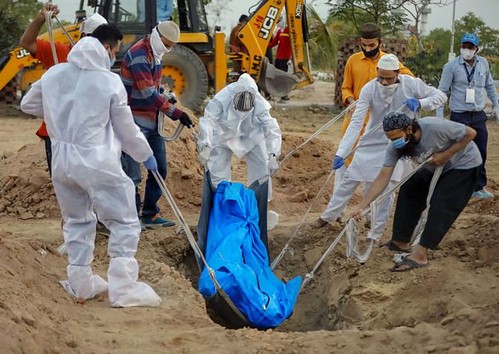In February of 2021, the seven-day average of new cases hovered around 12,000 daily confirmed cases, a significant decline from the November caseload, according to CNBC [1]. With newfound confidence, regulations and restrictions became more lax. India, the vaccine powerhouse and one of the few countries with good initial control, had overcome what swept others by storm. Right?
Come late April 2021, it became clear that what had been brewing silently was a fate more deadly than ever in India’s history of COVID. The original record maximum of 93,000 daily confirmed cases number paled in comparison to the more recent 401,993 cases in a day [1]. If there’s anything more apt at being the poster child for exponential growth, it is India at this very moment.
But how did it get so bad?
One etiology includes lack of governmental surveillance of concerning variants and an untimely response. Wion News reports that India’s most recent particular AP COVID-19 variant known as N440K has been slated to be 15 times more virulent than the current strains [2]. Another notable variant is the B.1.617 strain initially identified in the United Kingdom, accused of being the “escape” variant behind the catastrophic number of infections in such a short time [3].
Certain Roman health authorities refuted this notion, pointing instead to religious events exempted from new health guidelines such as Kumbh Mela where about 70 lakh people (7,000,000) participated with little masking or distancing, per NDTV. Another such gathering includes the recent agricultural protests in New Delhi against recently passed policies [4].
The final outcome of all this has been a more fatal second wave, adding to the cumulative total of 222,478 deaths, with the peak believed to be seen later this month [1].
However, these numbers fail to highlight the wails of family members slumped over the gurneys of their loved ones outside the 55-bed hospital housing 100+ patients beyond max capacity. Or even the patients inside waiting three to four days just to be seen by a provider. Any extra space is turned into a makeshift ICU. Mass cremation sites have been undergoing rapid expansion to accommodate all the bodies that quite literally continue to pile up [5].
On the other side, as a first-generation Indian living in the states, loud international phone calls from family in India at 10 PM about life and COVID are not unusual. I hear how my elderly aunts and uncles have gone nowhere aside from the occasional step outside for the past year. How every task and chore is to be done by their hand since domestic workers left to go back to their villages. About how curfew is at 8 PM, with the threat of arrest otherwise. How coworkers getting COVID left and right is not unusual. How my aunt, being partially vaccinated, got the virus and is still recovering. How every week there is more news of my parents’ close childhood friends passing away. To hear about families we know losing more than half their constituents is the most harrowing.
More recently, I was informed that my cousin’s in-laws were hospitalized, and are on oxygen. His wife stays at home with their four-year-old, while he stays at another house due to their fear of infecting him. Once a day he will visit them and pick up his tiffin, wave to his son from afar, and then leave. He has learned to stop asking when “dad will be able to come in” or when he will see his grandparents. As someone who has never experienced physical school, he has only ever known the quiet and calamity of COVID. In his mind, the mask is a permanent and typical garb, the six feet personal bubble an absolute necessity, and the separation of family a norm.
Experiencing this from across the globe has thus come with a certain inner notion of powerlessness; while this deadly strain may be so far away, it remains close to the ones close to me. It is a notion that I imagine many others share about this situation and about COVID in general. And while we are not there to lend a hand or labor, there are other ways to support the vigorous efforts that continue there. Through some research, one thing is certain, and it is that basic donations go far.
- Choudhury SR. India reports record Covid cases again — with over 386,000 new infections. CNBC. Published April 30, 2021.
- Desk, Gravitas. “India’s Andhra Pradesh COVID-19 Variant: N440K Is 15 Times More Virulent.” WION, 4 May 2021,
- What we know about India COVID variant as virus sweeps South Asia. Published April 30, 2021.
- 70 Lakh Participated In Kumbh Mela Held Amid Covid Surge. NDTV.com. Published May 1, 2021. Accessed May 7, 2021.
- Bajekal N. How India’s COVID-19 Crisis Spiraled Out of Control. Time. Published April 28, 2021. https://time.com/5964796/india-covid-19-failure/
Karishma Kothari is a member of University of Arizona College of Medicine Phoenix Class of 2023. She graduated from Arizona State University in 2019 with a major in medical microbiology. In her spare time, she enjoys film, the outdoors, painting, gardening, learning to play instruments, and skateboarding. She welcomes discussions of all topics, especially the odd anecdote.
Email: kkothari@email.arizona.edu


